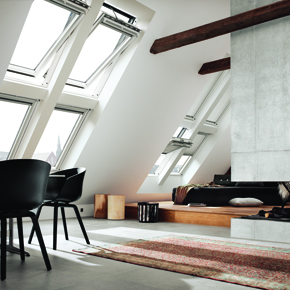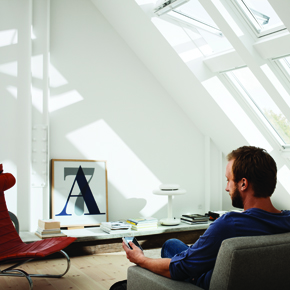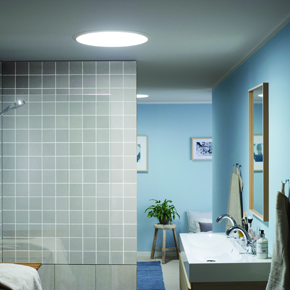
Natural vs mechanical ventilation solutions
With the drive towards developing sustainable building solutions, improving the energy efficiency and airtightness of new houses has become more important than ever. This has resulted in a mixed understanding of the most appropriate method to ventilate sustainable homes and, quite often, this causes homeowners to use ineffective or inadequate solutions.
This feature from VELUX Roof Windows, featured in the September issue of ABC+D Magazine, takes a look at the various options available…
The combination of modern airtight design and ongoing lifestyle changes underlines the need to understand the benefits of proper ventilation.
It is important to remember that 90% of the air we breathe comes from the indoor environment due to the amount of time we spend in buildings at home or at work. There is also a growing reluctance to open windows due to the need to keep heat in during the colder months of the year, reduce noise and pollution and keep the home secure.
A lack of adequate ventilation causes problems to our homes by building up humidity, gases from furniture and furnishings, particles, biological compounds and radioactive gas. This can have a negative impact on the wellbeing of a home, so it is important to make sure our indoor environments have plenty of fresh air and are ventilated properly.
There are two general means of ventilation – natural and mechanical – and it is important to consider both methods before deciding on which process is the right solution for the project or home.
Natural ventilation Natural ventilation is best suited to dual aspect homes, the strategic positioning of windows at high and low levels on the same façade will provide an adequate means of ventilating using the stack effect – the movement of air in and out of buildings.
Natural ventilation is easy to operate by opening and closing a window. However, there can be challenges in implementing a natural ventilation strategy. For example:
- Families spend most of their day out at work and school so the house is empty with windows closed for security reasons
- A lack of understanding of the way natural forces ventilate a building results in the wrong windows being opened at the wrong time
- Demands of family life make the opening and closing of windows low on the list of priorities
- The perception that windows cannot be opened in winter due to heat loss
- Slow reaction to operating windows by the occupants (the human factor) can result in overheating in the summer and excessive heat loss in the winter
Mechanical ventilation Mechanical ventilation is usually considered where a house has been designed for energy efficiency, such as a zero carbon home, which has exceptional airtightness and where heat recovery (MVHR) is required.
Of course, the Building Regulations have always required some form of mechanical ventilation in kitchens, bathrooms and other areas with high humidity and odours using either intermittent extract fans or a balanced centralised system.
As with natural ventilation, there are challenges in implementing a full mechanical ventilation strategy. These include:
- Homeowners assuming that a running fan is costing money, leading them to switching it off
- Lack of maintenance and servicing over time reducing the quality of the air circulating the home
- Failure of components causing inadequate pre-heating of an MVHR system in the winter, leading to cold draughts
- Lack of understanding resulting in improper use of the system
- Poor installation causing the mechanical ventilation system to underperform and negatively impact the indoor environment
So which system, natural or mechanical, is best to use? There is no formula to determine which system is best to use when looking at a whole-year lifecycle analysis but there is plenty of scientific evidence and case study examples to show that natural ventilation is easier to manage and cost-free.
However, there is also evidence to show that the use of mechanical ventilation with heat recovery in the winter helps to heat the inside space and reduce the amount of energy required for heating, thereby reducing the overall CO2 footprint. Of course, this is subject to the installation being carried out to the required standard.
It is generally recognised that future sustainable solutions may well benefit from a hybrid ventilation solution, where natural ventilation is used throughout the warmer months and mechanical ventilation with heat recovery is used during colder months.
In addition, it is important that ventilation is adequately controlled for all seasons, which means households could overcome the human factor by automating specific windows in the home. This would ensure that a regular and timed ventilation strategy is in place regardless of lifestyle or family commitments, or indeed the time of year.
Ventilating properly Automated roof windows can provide a means of natural ventilation using the stack effect. This solution can be operated securely and independently of any mechanical system, for all months of the year, closing automatically if it starts to rain.
This development brings many ventilation benefits to homeowners including predefined programmes, enabling a range of comfort levels based on specific needs such as Good Morning, Good Night, Ventilation, On Holiday and much more.
With a touch-screen control pad, every window can be reached easier and faster – from anywhere in the home or building. Ultimately, when it comes to ventilating your home properly, the main thing to remember is: build tight, ventilate right.
Latest news

22nd November 2024
Purplex: A tough Budget, but opportunity still knocks
Incoming governments, especially those with significant mandates, inevitably come into power on a tidal wave of optimism coupled with hope that ‘Things can only get better’. Andrew Scott, MD of construction-focused, full-service agency Purplex, talks…
Posted in Articles, Building Industry News, Building Services, Information Technology, news, Posts, Research & Materials Testing
22nd November 2024
Pop Up Power Supplies Gets Arty in Yorkshire
Pop Up Power Supplies has installed 13 new electricity units at The Hepworth Wakefield – read more in this article…
Posted in Articles, Building Industry News, Building Products & Structures, Building Services, Case Studies, Civil Engineering, Facility Management & Building Services, Garden, Hard Landscaping & Walkways, Landscaping, Posts, Restoration & Refurbishment, Retrofit & Renovation
22nd November 2024
OPT Services Revolutionises Fibre Cable Capping with Eco-Friendly Innovation
UK-based OPT Services has unveiled SlimLine™ Capping, a groundbreaking fibre cable protection solution that promises to deliver significant environmental and installation advantages to the fibre optic industry.
Posted in Articles, Building Industry News, Building Products & Structures, Building Services, Facility Management & Building Services, Information Technology, Innovations & New Products, Sustainability & Energy Efficiency
22nd November 2024
CRL: The elegance of Paris balconies - a modern touch for any home
Paris balconies, with their timeless charm and practicality, are becoming something of an architectural staple in urban and rural environments, as CRL explains here…
Posted in Articles, Balustrades and Guardrails, Building Industry News, Building Products & Structures, Case Studies, Garden, Glass, Glass Projects, Restoration & Refurbishment, Retrofit & Renovation
 Sign up:
Sign up: